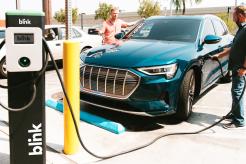Reliability is a sore spot for the fast-growing EV charging station industry; customer satisfaction with public Level 2 charging stations has dropped since 2021, according to JD Power. We can understand the frustration here: EV drivers may find themselves stranded or unable to quickly charge their vehicles without reliable, high-quality charging stations.
Any nascent technology can expect to face speedbumps on the road to widespread adoption, but that doesn’t mean EV charging station owners should be content with faulty, unreliable stations. So, how can charging station owners ensure reliability?
Let’s dive into our top tips!
1. Use High-Quality Hardware

(Photo by myenergi on Unsplash)
This tip may go without saying, but do your research to ensure you pick the best EVSE (electric vehicle supply equipment) on the market. Focus on well-known brands with good track records that offer comprehensive warranties. Here are ten of our favorite EV charging station solutions.
2. Ensure Proper Installation and Maintenance

(Photo by OPPO Find X5 Pro on Unsplash)
Once you’ve chosen your EVSE, it’s critical to ensure it’s properly installed. Use certified installers who have experience with EV charging systems, and familiarize yourself with any relevant safety standards and requirements. You can use resources like EvoCharge and EV Charging Installers of America to find qualified professionals near you.
3. Monitor Charging Station Performance Over Time

(Photo by ThisisEngineering RAEng on Unsplash)
Monitor your charging stations over time and ensure that they’re running correctly. Schedule regular maintenance checks for electrical issues and clean and replace parts. Monitoring data from charging sessions can help identify problems before they become significant. Track and analyze this data to determine if any stations need further maintenance or repairs.
Depending on your monitoring software, you should be able to implement 24/7 alerts and automated troubleshooting. Round-the-clock alerts should be in place to notify operators when charging stations exceed predetermined thresholds. These alerts help owners address problems quickly, preventing further downtime or disruption.
When installing remote monitoring systems for EV charging stations, ensure that the system is compatible with your existing infrastructure and can monitor all the features you need to track. The system needs reliable internet connectivity and must be secure from hacking threats. And finally, be sure to regularly check the system for any faults or errors and be prepared to replace components if necessary.
4. Ensure Compliance
Operators should ensure that their charging stations comply with local, state, and federal regulations. Compliance will help to ensure that the infrastructure is safe and reliable for EV drivers. Operators should also conduct regular assessments of the entire system to identify any potential issues or areas of improvement.
5. Develop Scalable Solutions
You may start by installing just two or three charging stations on your property, but as electric vehicle adoption skyrockets, you’ll need to be prepared to scale up your infrastructure.
To develop scalable solutions, operators should consider their current needs and future growth goals: how many and what type of chargers will you install? It’s also essential to determine which type of charging infrastructure will be most suitable for your location, including Level 2 or DC fast-charging solutions. When thinking about your long-term plans for EV charging stations, consider these 13 questions.
6. Train Employees

(Photo by Sincerely Media on Unsplash)
Operators should train their employees to properly and safely manage charging stations. Training includes educating them on the basics of electrical safety, monitoring the system for faults or errors and identifying any potential issues. It’s also essential to ensure that employees are familiar with the different types of EV charging stations and how they work. EVITP offers training and certification.
When training employees, emphasize the importance of safety first and foremost. Charging stations require careful operation and regular monitoring, so staff must understand how to use them correctly and properly maintain them.
7. Plan For Peak Demand and Surges
Have a plan in place for dealing with peak demand and unexpected surges. Planning will help you meet your customers’ needs without compromising reliability or safety. Peak shaving can be a particularly effective strategy, as it will help to reduce spikes in demand and keep your charging stations running at their optimal level.
8. Consider Your Monetization Strategy

(Photo by Patrick Perkins on Unsplash)
If you can profit off your EV charging stations, it’ll be much easier to justify reinvesting in them, keeping them up to date, and ensuring they remain reliable. Determine the best monetization options for your charging network and ensure that it aligns with your current needs and future goals.
9. Stay Up To Date With Industry Trends
Finally, stay up to date with electric vehicle trends. Electric vehicle adoption is exploding, and new technology and standards are constantly emerging. Your charging station may qualify as fast and reliable now, but in a year or two, you may need to upgrade to remain competitive. By understanding the current market, you’ll better plan for the future and ensure your charging station remains a reliable resource for EV drivers.
Following these steps, operators can ensure that their charging stations are reliable, safe, and compliant.
Are you interested in learning more about EV charging infrastructure and reliability? Join us at our EV Charging Summit & Expo!






